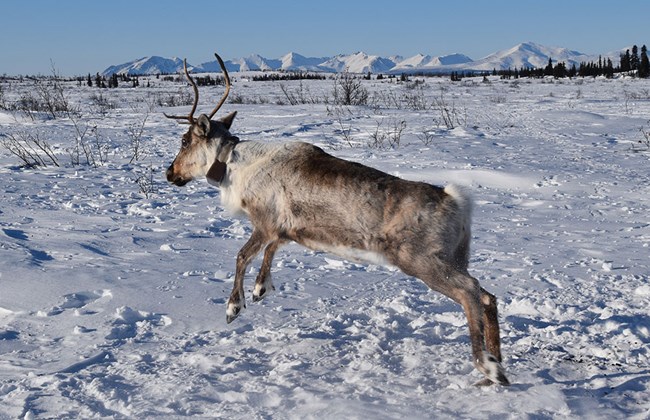Last updated: December 12, 2022
Article
When are newly collared caribou representative of the herd?

NPS/Kyle Joly
Following every individual in a population is generally not possible, especially in vast and remote areas like northwest Alaska. Thus, a key tool of science and management is sampling individuals to gain insights about the population in general. But an important requirement of these samples is that they must be representative, which means a given individual is similar to or doing similar things as the rest of the population. GPS collars have become a fundamental component of wildlife biology and management, and this is especially true in Alaska where wildlife populations range across an immense landscape.
An important question biologists face is: when are newly collared animals representative of the rest of the population? Often, collaring occurs within a limited area and these new collars may not represent the whole population living over a wider area. National Park Service biologists worked with colleagues from ABR, Inc. (Environmental Research and Services), the Alaska Department of Fish and Game, and the North Slope Borough to develop a new method to test when newly collared animals could be considered representative of the population using two Alaskan caribou herds – the Western Arctic Herd and the Teshekpuk Herd. We found that in the Western Arctic Herd, collars deployed during fall migration at a single location tend to remain unmixed from the rest of the herd through the winter. This is likely because movement becomes slowest in winter and animals do not mix with the rest of the herd. Mixing occurs after winter, when the females reach the calving grounds in spring. For the neighboring Teshekpuk Herd, collared females in spring tend to become representative of the herd within a few weeks, when the herd gathers together to avoid insect harassment.
Achieving a representative sample of marked animals: A spatial approach to evaluating post-capture randomization
Abstract
A fundamental assumption of many ecological studies is that researchers are studying a representative sample of the population of interest. However, fish and wildlife studies, including many telemetry studies, often rely upon data from marked individuals that are sampled opportunistically rather than randomly and may provide little information on unmarked individuals. Data that are unrepresentative at the time of marking may need to be censored until marked animal distributions are representative of the population. In the absence of additional data on unmarked individuals, evaluating the representativeness of newly marked individuals within a population of interest can be difficult. If previously marked individuals can be assumed to be spatially representative of the population, comparing the spatial distributions of different cohorts of marked individuals can provide an alternative means to assess the representativeness of newly marked animals. We used simulations to assess the effectiveness of a randomization test that compared the spatial distribution between newly marked and previously marked individuals as an alternative to recapture-based methods for evaluating mixing of newly marked individuals with the population of interest and compared different metrics of spatial overlap. We then tested this randomization test on radio-collared caribou (Rangifer tarandus) from 2 different herds with very different marking strategies. We found that, based on simulation results, kernel-based metrics outperformed cluster analysis metrics and that Bhattacharyya's Affinity (BA) index of kernel overlap was a good metric to identify differences in spatial distribution between marked cohorts. The time it took for newly marked caribou to become mixed with previously marked animals was primarily related to the timing of marking in relation to seasonal movement patterns (periods of aggregation and dispersion, and seasonal differences in spatial fidelity) and the spatial distribution of marking relative to seasonal distribution. In some cases, mixing did not occur until calving aggregations formed in early June. We recommend that researchers evaluate the assumption that marked individuals are spatially representative of their study population and carefully assess sampling time and location of their marking program to increase the likelihood that marked individuals represent the population of interest.
Prichard, A. K., K. Joly, L. S. Parrett, M. D. Cameron, D. A. Hansen, and B. T. Person. 2022. Achieving a representative sample of marked animals: A spatial approach to evaluating post-capture randomization. Wildlife Society Bulletin e1398.
